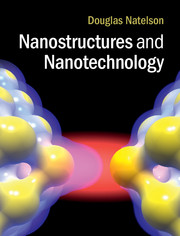Book contents
- Frontmatter
- Contents
- Preface
- Part I
- Part II
- 6 Charge transport and nanoelectronics
- 7 Magnetism and magnetoelectronics
- 8 Photonics
- 9 Micro- and nanomechanics
- 10 Micro- and nanofluidics
- 11 Bionanotechnology: a very brief overview
- 12 Nanotechnology and the future
- Appendix Common quantum mechanics and statistical mechanics results
- References
- Index
11 - Bionanotechnology: a very brief overview
from Part II
Published online by Cambridge University Press: 05 July 2015
- Frontmatter
- Contents
- Preface
- Part I
- Part II
- 6 Charge transport and nanoelectronics
- 7 Magnetism and magnetoelectronics
- 8 Photonics
- 9 Micro- and nanomechanics
- 10 Micro- and nanofluidics
- 11 Bionanotechnology: a very brief overview
- 12 Nanotechnology and the future
- Appendix Common quantum mechanics and statistical mechanics results
- References
- Index
Summary
Biology has clear, direct relevance to nanoscale science and technology. The organelles within our cells are exquisite nanoscale machines, with the capability to fabricate complex structures with molecular precision in a fluctuating electrolytic environment. Individual protein molecules can function as motors and pumps, transducing chemical energy into useful mechanical or electrochemical work. Biological systems can build complex structures from the nano to the macro scale incorporating inorganic as well as organic constituents. Moreover, there is a tremendous societal drive toward greater understanding of this biological apparatus, motivated by the quest for basic knowledge, the desire to leverage biological mechanisms to accomplish useful tasks, and the obvious ramifications for clinical treatment of disease.
Because of the vast diversity of biological systems, this chapter does not remotely attempt to survey all of bionanotechnology. Rather, I will emphasize a handful of key concepts relevant to molecular and cell biology and highlight major research directions. View this as a very simple primer more than as a textbook-depth explication. For a book-length discussion of many of these topics, I recommend D. S. Goodsell's Bionanotechnology: Lessons from Nature (Wiley-Liss, 2004) as a good place to start.
Basic elements and tools of bionano
Intermolecular interactions relevant to bionano
Biological activity has evolved to take place in a complex, fluctuating chemical environment near room temperature (though extremophile bacteria push the limits of this generalization). So that biological systems can respond to their environments, metabolize nutrients, and generally carry on the business of living, they support many mechanical and chemical processes that operate on energy scales comparable to kBT. As a result, while covalent interactions at the eV energy scale remain very important, many interesting biological materials and processes depend on noncovalent interactions closer to the thermal energy available from the surroundings.
Figure 11.1 schematically highlights four relevant noncovalent interactions.
- Type
- Chapter
- Information
- Nanostructures and Nanotechnology , pp. 516 - 542Publisher: Cambridge University PressPrint publication year: 2015



